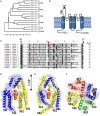Understanding the Cap Structure in K2P Channels
- PMID: 27378938
- PMCID: PMC4906011
- DOI: 10.3389/fphys.2016.00228
Understanding the Cap Structure in K2P Channels
Keywords: K2P channels; K2P potassium channels structure; cap structure; potassium channels; two-pore domain channel.
Figures

Similar articles
-
An allosteric ligand-binding site in the extracellular cap of K2P channels.Nat Commun. 2017 Aug 29;8(1):378. doi: 10.1038/s41467-017-00499-3. Nat Commun. 2017. PMID: 28851868 Free PMC article.
-
Energetic differences between non-domain-swapped and domain-swapped chain connectivities in the K2P potassium channel TRAAK.RSC Adv. 2018 Jul 25;8(47):26610-26618. doi: 10.1039/c8ra04159h. eCollection 2018 Jul 24. RSC Adv. 2018. PMID: 35541058 Free PMC article.
-
Functional mutagenesis screens reveal the 'cap structure' formation in disulfide-bridge free TASK channels.Sci Rep. 2016 Jan 22;6:19492. doi: 10.1038/srep19492. Sci Rep. 2016. PMID: 26794006 Free PMC article.
-
Physiology and pharmacology of two-pore domain potassium channels.Curr Pharm Des. 2005;11(21):2717-36. doi: 10.2174/1381612054546824. Curr Pharm Des. 2005. PMID: 16101451 Review.
-
Endocytosis as a mode to regulate functional expression of two-pore domain potassium (K₂p) channels.Pflugers Arch. 2015 May;467(5):1133-42. doi: 10.1007/s00424-014-1641-9. Epub 2014 Nov 22. Pflugers Arch. 2015. PMID: 25413469 Free PMC article. Review.
Cited by
-
Mechanosensitive Ion Channels: Their Physiological Importance and Potential Key Role in Cancer.Int J Mol Sci. 2023 Sep 5;24(18):13710. doi: 10.3390/ijms241813710. Int J Mol Sci. 2023. PMID: 37762011 Free PMC article. Review.
-
Conduction and Gating Properties of the TRAAK Channel from Molecular Dynamics Simulations with Different Force Fields.J Chem Inf Model. 2020 Dec 28;60(12):6532-6543. doi: 10.1021/acs.jcim.0c01179. Epub 2020 Dec 9. J Chem Inf Model. 2020. PMID: 33295174 Free PMC article.
-
Potassium Ion Channels in Glioma: From Basic Knowledge into Therapeutic Applications.Membranes (Basel). 2023 Apr 15;13(4):434. doi: 10.3390/membranes13040434. Membranes (Basel). 2023. PMID: 37103862 Free PMC article. Review.
-
The Pharmacology of Two-Pore Domain Potassium Channels.Handb Exp Pharmacol. 2021;267:417-443. doi: 10.1007/164_2021_462. Handb Exp Pharmacol. 2021. PMID: 33880623
-
TASK-3 Downregulation Triggers Cellular Senescence and Growth Inhibition in Breast Cancer Cell Lines.Int J Mol Sci. 2018 Mar 29;19(4):1033. doi: 10.3390/ijms19041033. Int J Mol Sci. 2018. PMID: 29596383 Free PMC article.
References
-
- Barel O., Shalev S. A., Ofir R., Cohen A., Zlotogora J., Shorer Z., et al. . (2008). Maternally inherited Birk Barel mental retardation dysmorphism syndrome caused by a mutation in the genomically imprinted potassium channel KCNK9. Am. J. Hum. Genet. 83, 193–199. 10.1016/j.ajhg.2008.07.010 - DOI - PMC - PubMed
LinkOut - more resources
Full Text Sources
Other Literature Sources
Miscellaneous

